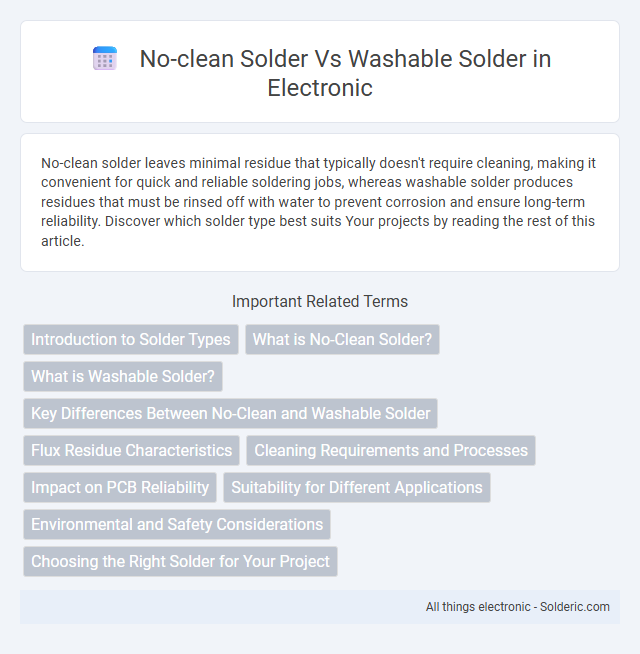No-clean solder leaves minimal residue that typically doesn't require cleaning, making it convenient for quick and reliable soldering jobs, whereas washable solder produces residues that must be rinsed off with water to prevent corrosion and ensure long-term reliability. Discover which solder type best suits Your projects by reading the rest of this article.
Comparison Table
| Feature | No-Clean Solder | Washable Solder |
|---|---|---|
| Flux Residue | Non-corrosive, minimal residue; no cleaning required | Corrosive residue; requires post-soldering cleaning |
| Cleaning Process | Not needed, saves time and cost | Essential; typically cleaned with water or solvents |
| Use Cases | Consumer electronics, where cleaning is impractical | Medical devices, military; applications needing residue-free boards |
| Reliability | Good, but flux residues may affect certain sensitive circuits | High, ensures contamination-free solder joints |
| Cost | Lower total cost due to no cleaning step | Higher cost due to cleaning requirements |
| Environmental Impact | Less water and solvent use; eco-friendlier process | Uses water/solvents; requires treatment of cleaning waste |
Introduction to Solder Types
No-clean solder contains flux residues designed to remain on the circuit without cleaning, ensuring minimal corrosion and reliable electrical performance. Washable solder, on the other hand, uses water-soluble flux that requires cleaning after soldering to prevent residue buildup and potential conductivity issues. Selecting between these solder types depends on the application's need for residue presence, cleaning processes, and long-term circuit reliability.
What is No-Clean Solder?
No-clean solder is a type of solder paste formulated with flux residues that remain on the PCB without requiring cleaning after soldering, making it ideal for products sensitive to moisture or cleaning solvents. Its flux residue is designed to be non-corrosive and non-conductive, minimizing risk to circuit performance and reliability. Choosing no-clean solder simplifies the manufacturing process, reducing costs and processing time while ensuring long-term device integrity.
What is Washable Solder?
Washable solder is a type of solder used in electronics assembly that leaves a residue designed to be removed with water-based cleaning solutions, ensuring improved reliability and appearance. This solder typically contains flux that activates during soldering but is easily washable to prevent corrosion or conductive residue on your circuit boards. Choosing washable solder is ideal when thorough cleaning of solder flux residues is required to maintain optimal device performance and longevity.
Key Differences Between No-Clean and Washable Solder
No-clean solder flux leaves minimal, non-corrosive residue that does not require post-solder cleaning, making it ideal for electronics where cleaning access is limited. Washable solder flux contains water-soluble residues that must be thoroughly removed after soldering to prevent corrosion and ensure long-term reliability. The primary difference lies in residue management and cleaning requirements, with no-clean solder optimizing for ease of use and washable solder emphasizing residue removal for delicate or high-reliability applications.
Flux Residue Characteristics
No-clean solder flux leaves minimal, non-corrosive, and non-conductive residue that does not require removal after soldering, making it suitable for applications where cleaning is difficult or costly. Washable solder flux produces residues that are corrosive and conductive, necessitating thorough cleaning with water or solvent-based solutions to prevent potential reliability issues. Understanding the flux residue characteristics is crucial for selecting the appropriate solder type based on the electronic assembly's performance and environmental requirements.
Cleaning Requirements and Processes
No-clean solder formulations eliminate the need for post-soldering cleaning by leaving minimal, non-conductive residues that are safe for most electronic assemblies, reducing manufacturing time and costs. Washable solder fluxes require thorough cleaning processes using specific solvents or aqueous cleaning systems to remove residues, preventing potential corrosion and ensuring long-term reliability. Selection between no-clean and washable solder depends on device sensitivity, production volume, and cleaning infrastructure availability.
Impact on PCB Reliability
No-clean solder leaves a minimal residue that rarely affects PCB reliability, making it suitable for most consumer electronics where cleaning is impractical. Washable solder requires post-soldering cleaning to remove flux residues, which, if not properly cleaned, can lead to corrosion or electrical leakage, ultimately compromising the PCB's long-term performance. Choosing the right flux type directly impacts your PCB's durability and operational stability.
Suitability for Different Applications
No-clean solder is ideal for electronics where cleaning residues is difficult or undesirable, such as in densely packed circuit boards or sensitive components. Washable solder suits applications requiring high reliability and thorough residue removal, like military or medical devices, where flux residues must be eliminated to prevent corrosion. Your choice between these solders depends on the cleaning process compatibility and the operational environment of the finished product.
Environmental and Safety Considerations
No-clean solder flux leaves minimal residue that is non-toxic and does not require cleaning, reducing the need for harmful solvents and minimizing environmental impact. Washable solder flux, while effective at removing residues with water, involves using water treatment systems to handle potentially hazardous waste, posing safety and environmental challenges. Your choice should consider whether reducing chemical disposal or managing wastewater aligns better with your environmental and safety priorities.
Choosing the Right Solder for Your Project
Choosing the right solder for your project depends on the type of flux residue and cleaning requirements. No-clean solder leaves minimal, non-conductive residues that often do not require post-soldering cleaning, making it ideal for low-maintenance electronics. Washable solder uses water-soluble flux, necessitating thorough cleaning to prevent corrosion and ensure long-term reliability in critical applications.
No-clean solder vs washable solder Infographic

 solderic.com
solderic.com